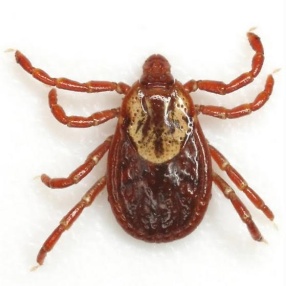
What is Rocky Mountain spotted fever?
Rocky Mountain spotted fever (RMSF) is a disease caused by a bacterium called Rickettsia rickettsii. It is transmitted to humans most often by the bite of an infected American dog tick, but the Rocky Mountain wood tick and the brown dog tick have also caused the disease. Other types of Rickettsia can cause similar illnesses. As a group these illnesses are referred to as the “spotted fever rickettsioses.”
Who gets RMSF?
Anyone who has exposure to infected ticks can get RMSF. The disease is most often reported among males, American Indians, and people 50-69 years of age. People with frequent exposure to dogs and who reside near wooded areas or areas with high grass are more likely to come in contact with ticks.
How is RMSF spread?
RMSF is spread by the bite of an infected adult tick, or by contamination of the skin with tick blood or feces. It cannot be spread from one person to another. Ticks must be attached for at least 4 hours to transmit RMSF.
What are the symptoms of RMSF?
RMSF is characterized by a sudden onset of moderate to high fever, severe headache, fatigue, deep muscle pain, chills and rash. The rash begins on the legs or arms, may include the soles of the feet or palms of the hands, and may spread rapidly to the trunk or rest of the body.
How soon after exposure do symptoms appear?
Symptoms usually appear within two weeks of the bite of an infected tick.
How is RMSF diagnosed?
RMSF can be diagnosed through laboratory tests of blood or skin.
What is the treatment for RMSF?
Rickettsial infections can be treated with certain antibiotics. Prompt treatment may decrease the chance of developing serious illness.
How can RMSF be prevented?
As much as possible, avoid areas where ticks are found, such as woods or fields with tall brush and weeds. When going into the woods or other places where ticks are common, wear light-colored long-sleeved shirts and long pants, and tuck your pant legs into your socks. If working or playing in a tick-infested area, watch for and remove any surface ticks, and look for ticks on the body every 3-4 hours. Applying tick repellents to legs and clothing may be helpful to prevent tick attachment. Be sure to follow label instructions before using any repellent. Tick populations may be controlled by applying pesticides to vegetation along trails and by mowing grass frequently in yards and outside fences.
What should I do if I find a tick attached to my body?
Any attached ticks should be removed as soon as possible. To remove an attached tick, grasp the tick with tweezers as close as possible to the skin where it is attached, and pull upward and out with a firm and steady pressure. If tweezers are not available, use fingers shielded with a cloth, tissue, or rubber gloves. Do not handle the tick with bare hands. Be careful not to squeeze, crush or puncture the tick because its body fluids may contain bacteria. After removing the tick, thoroughly disinfect the bite site and wash your hands. See or call a physician if you are concerned that the tick was not completely removed. If the tick is removed within 3 hours after attachment, the risk of tickborne infection is reduced.
Does past infection with RMSF make a person immune?
Yes, a person who gets RMSF probably cannot get it again.
How can I get more information about RMSF?
- If you have concerns about RMSF, contact your healthcare provider.
- Call your local health department. A directory of local health departments is located at https://www.vdh.virginia.gov/LHD/index.htm.
- Visit the Centers for Disease Control and Prevention website at http://www.cdc.gov/rmsf/index.html.
